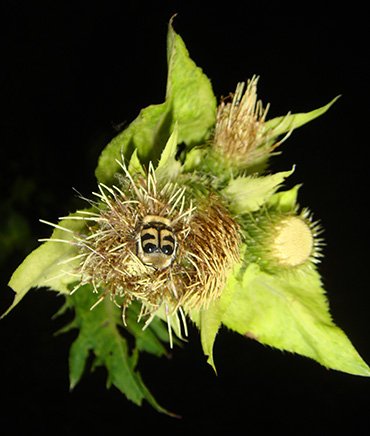WHITE NIGHTS Artificial light at night upsets pollinating insects and plants, and that disruption may spread into daylight hours.

For flowers, too much light at night could lead to a pollination hangover by day.
Far from any urban street, researchers erected street lights in remote Swiss meadows to mimic the effects of artificial light pollution. In fields lit during the night, flowers had 62 percent fewer nocturnal visitors than flowers in dark meadows, researchers report August 2 in Nature.
For one of the most common flowers, daytime pollination didn’t make up for nightly losses, says ecologist Eva Knop of the University of Bern in Switzerland. In a detailed accounting of the pollination life of cabbage thistles (Cirsium oleraceum), Knop and colleagues found that night-lit plants produced 13 percent fewer seeds overall than counterparts in naturally dark places.
Night lights could affect the entire network of plants and pollinators, the team suggests. In the test fields, nighttime pollination wasn’t just the business of a few kinds of specialized moth-loving plants. Flowers that fed a wide range of nighttime visitors also attracted a broad buzzing circus of different kinds of daytime pollinators. If the daytime insects don’t make for up nocturnal losses, a flower’s population might dwindle. And a lot of insects, both day and night, might then feel the loss of nectar and foliage, Knop says.
More than 80 percent of flower species get some help from animals in making seeds, and none evolved with light after sundown. “I hope people start to realize that it’s really something that changes the whole ecosystem,” Knop says.
The new study is the first to show how artificial light affects plants’ ability to make seeds, she says. The test is also unusual because it considers all kinds of insect pollinators instead of focusing on, say, only night-flying moths.
NIGHT SHIFT A cabbage thistle bloom hosts a guest beetle after dark, the kind of plant-pollinator interaction checked (with night goggles if necessary) in an ambitious field test.

This big-picture view was so not easy to achieve. Finding possible dead-dark sites in highly developed Europe to set up LED lamps was impossible, so researchers worked in 14 dark-as-possible, remote meadows in land rising toward the Alps. But that created a problem. “If you don’t have light, you don’t have power,” Knop points out. To avoid generator growls and smells confounding their results, researchers painstakingly scouted sites where possible near water-powered energy sources and overall used “really long cables.”
For the sites with natural night, researchers measured pollination by patrolling set paths and catching any insect wriggling on a flower — in complete darkness, of course. The team used night-vision goggles but still didn’t have a perfect view, she says. It’s “not that easy to catch insects without three-dimensional vision.”
Besides paying special attention to the commonly visited cabbage thistle, researchers pieced together the whole network of which pollinator species visited which plant species day or night. Analysis of this Matterhorn of data suggested that changes in the night crew could affect daytime meadows.
The idea that night light could have broad knock-on effects on daytime pollinators is still speculation at this point, says ecologist Darren Evans of Newcastle University in England, who also studies light pollution and pollination. But the risk of such spillover warrants more attention.
Source: https://www.sciencenews.org/article/light-pollution-can-foil-plant-insect-hookups-and-not-just-night
Not indicating that the content you copy/paste is not your original work could be seen as plagiarism.
Some tips to share content and add value:
Repeated plagiarized posts are considered spam. Spam is discouraged by the community, and may result in action from the cheetah bot.
Creative Commons: If you are posting content under a Creative Commons license, please attribute and link according to the specific license. If you are posting content under CC0 or Public Domain please consider noting that at the end of your post.
If you are actually the original author, please do reply to let us know!
Thank You!
I always say that nature knows best.....and human wants to show, how developed he is, but in reality he shows just how he needs to study a lot about the nature and its course
Yes , It is , Thanks for your comment :)
Congratulations! This post has been upvoted from the communal account, @minnowsupport, by shamima948 from the Minnow Support Project. It's a witness project run by aggroed, ausbitbank, teamsteem, theprophet0, and someguy123. The goal is to help Steemit grow by supporting Minnows and creating a social network. Please find us in the Peace, Abundance, and Liberty Network (PALnet) Discord Channel. It's a completely public and open space to all members of the Steemit community who voluntarily choose to be there.
If you like what we're doing please upvote this comment so we can continue to build the community account that's supporting all members.